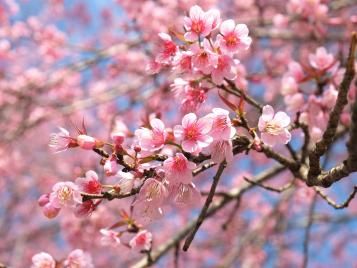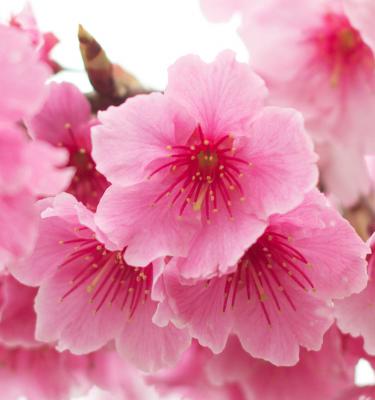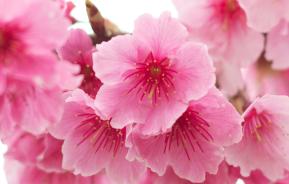There’s no doubt that if you want a tree with the wow factor in spring, then an ornamental or flowering cherry (Prunus) is the perfect choice. They are literally smothered in blossom and many provide excellent autumn foliage colours.
Many varieties are perfect for even small gardens and they come in a range of shapes that include columnar, spreading or weeping. And, of course, there are varieties of cherry that produce deliciously tasty cherry fruit.
How to grow flowering cherries
Cultivation
Flowering cherries prefer an open and sunny site, which isn’t too exposed. Strong winds in spring will blow away much of the blossom, reducing the overall flowering display.
They prefer a good, well-drained soil enriched with lots of organic matter which holds plenty of moisture in spring and summer and doesn’t dry out or become waterlogged. They will grow in most soils types, especially chalky and alkaline soils.
Flowering cherry varieties
There are numerous species and varieties, some being small or very slow growing making them suitable for all but the tiniest garden. Flower colours range from white through to deep pink. They may be single flowers or double with lots of petals which provide an even more spectacular display. Foliage colour can either be green or purple and many have beautiful autumn leaf colour too. One or too even have gorgeous mahogany or deep copper coloured bark.
The tree shape is an important consideration when choosing. Columnar or flagpole cherries are perfect for small spaces whereas spreading cherries are suitable for larger spaces and to provide a focal point or centrepiece. Weeping varieties don’t grow that tall and provide a waterfall of blossom.
The following are all excellent trees, suitable for small gardens.
- Prunus Accolade has a spreading growth habit and is covered in masses of light pink, semi-double flowers in April. In autumn, the leaves turn a rich orange or red.
- Prunus Amanogawa, the flagpole cherry, is thin and upright, bearing lots of semi-double, pale pink flowers. In autumn, the leaves turn orange and red.
- Prunus Kiku-shidare-zakura, Cheal’s weeping cherry, is a small, compact weeping tree. The blousy, double flowers are rich pink. The leaves are a gorgeous bronze colour when young and turn a mellow orange in autumn.
- Prunus Kojo-no-mai is a very small, slow growing and compact cherry – growing more like a shrub than a tree. It is perfect for growing in containers. Its branches have an attractive zig-zag pattern which look good even in winter. Profusely flowering even when young.
- Prunus serrula Dorothy Clive is a small, round-headed tree, with coppery-brown bark, white flowers and yellow autumn foliage colours.
- Prunus x subhirtella Autumnalis produces white, semi-double flowers intermittently from autumn to spring depending on the weather. Leaves turn yellow in autumn.

Planting flowering cherries
Plant bare-root trees between November and March, and container-grown ones any time of year but preferably not winter. Dig a hole 60x60cm (2x2ft) and 30cm (12in) deep. Add a layer of organic matter such as compost or well-rotted manure to the base of the hole and dig in.
Place the roots in the planting hole and adjust the planting depth so that the tree is planted at the same depth as it was originally growing and the top of the roots are level with the soil surface.
Mix in more organic matter with the excavated soil and fill in the planting hole. Stake the tree with a rigid tree stake and two tree ties so that it is fully supported against the prevailing winds. Water in well and apply a granular general feed over the soil around the tree. Add a 5-7.5cm (2-3in) deep mulch of well-rotted garden compost or bark chippings around the root area.
If planting in the lawn, create a turf-free circular bed around the tree with a minimum diameter of 60cm (2ft).
Suggested planting locations and garden types
Plant cherry blossom trees in flower borders and beds, focal point, city and courtyard gardens.
How to care for flowering cherries
Once planted and properly established, flowering cherries need very little aftercare. They may need watering during prolonged dry periods in summer. Feed with a general granular plant food in spring.
Unless essential, it is best not to carry out any pruning. If pruning is needed, it should be carried out when the tree is actively growing – from May to August – to prevent problems with bacterial canker and silver leaf diseases.
| Flowering season(s) | Spring, Autumn, Winter |
|---|---|
| Foliage season(s) | Spring, Summer, Autumn |
| Sunlight | Full sun |
| Soil type | Chalky, Clay, Loamy, Sandy |
| Soil pH | Neutral |
| Soil moisture | Moist but well-drained |
| Ultimate height | Up to 10m (33ft) |
| Ultimate spread | Up to 5m (16ft) |
| Time to ultimate height | 10-15 years |








